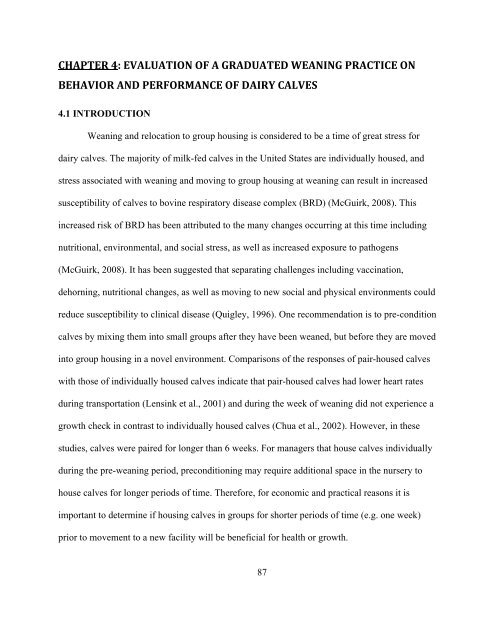Stanton PhD Thesis final_docx - Atrium - University of Guelph
Stanton PhD Thesis final_docx - Atrium - University of Guelph
Stanton PhD Thesis final_docx - Atrium - University of Guelph
You also want an ePaper? Increase the reach of your titles
YUMPU automatically turns print PDFs into web optimized ePapers that Google loves.
CHAPTER 4: EVALUATION OF A GRADUATED WEANING PRACTICE ON<br />
BEHAVIOR AND PERFORMANCE OF DAIRY CALVES<br />
4.1 INTRODUCTION<br />
Weaning and relocation to group housing is considered to be a time <strong>of</strong> great stress for<br />
dairy calves. The majority <strong>of</strong> milk-fed calves in the United States are individually housed, and<br />
stress associated with weaning and moving to group housing at weaning can result in increased<br />
susceptibility <strong>of</strong> calves to bovine respiratory disease complex (BRD) (McGuirk, 2008). This<br />
increased risk <strong>of</strong> BRD has been attributed to the many changes occurring at this time including<br />
nutritional, environmental, and social stress, as well as increased exposure to pathogens<br />
(McGuirk, 2008). It has been suggested that separating challenges including vaccination,<br />
dehorning, nutritional changes, as well as moving to new social and physical environments could<br />
reduce susceptibility to clinical disease (Quigley, 1996). One recommendation is to pre-condition<br />
calves by mixing them into small groups after they have been weaned, but before they are moved<br />
into group housing in a novel environment. Comparisons <strong>of</strong> the responses <strong>of</strong> pair-housed calves<br />
with those <strong>of</strong> individually housed calves indicate that pair-housed calves had lower heart rates<br />
during transportation (Lensink et al., 2001) and during the week <strong>of</strong> weaning did not experience a<br />
growth check in contrast to individually housed calves (Chua et al., 2002). However, in these<br />
studies, calves were paired for longer than 6 weeks. For managers that house calves individually<br />
during the pre-weaning period, preconditioning may require additional space in the nursery to<br />
house calves for longer periods <strong>of</strong> time. Therefore, for economic and practical reasons it is<br />
important to determine if housing calves in groups for shorter periods <strong>of</strong> time (e.g. one week)<br />
prior to movement to a new facility will be beneficial for health or growth.<br />
87

















